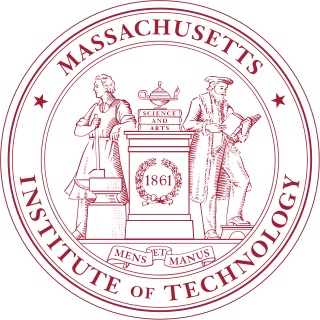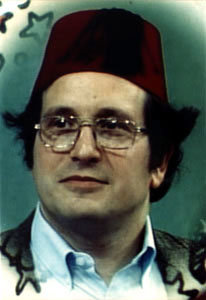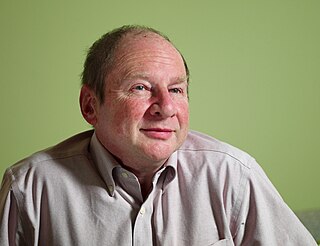Related Research Articles
Computer programming or coding is the composition of sequences of instructions, called programs, that computers can follow to perform tasks. It involves designing and implementing algorithms, step-by-step specifications of procedures, by writing code in one or more programming languages. Programmers typically use high-level programming languages that are more easily intelligible to humans than machine code, which is directly executed by the central processing unit. Proficient programming usually requires expertise in several different subjects, including knowledge of the application domain, details of programming languages and generic code libraries, specialized algorithms, and formal logic.

Frederick Phillips Brooks Jr. was an American computer architect, software engineer, and computer scientist, best known for managing the development of IBM's System/360 family of computers and the OS/360 software support package, then later writing candidly about those experiences in his seminal book The Mythical Man-Month.
Knowledge representation and reasoning is the field of artificial intelligence (AI) dedicated to representing information about the world in a form that a computer system can use to solve complex tasks such as diagnosing a medical condition or having a dialog in a natural language. Knowledge representation incorporates findings from psychology about how humans solve problems and represent knowledge in order to design formalisms that will make complex systems easier to design and build. Knowledge representation and reasoning also incorporates findings from logic to automate various kinds of reasoning, such as the application of rules or the relations of sets and subsets.

The Massachusetts Institute of Technology (MIT) is a private land-grant research university in Cambridge, Massachusetts. Established in 1861, MIT has played a significant role in the development of many areas of modern technology and science. Its reputation for innovation and rankings have made it one of the most prestigious universities in the world.

Gerald Jay Sussman is the Panasonic Professor of Electrical Engineering at the Massachusetts Institute of Technology (MIT). He has been involved in artificial intelligence (AI) research at MIT since 1964. His research has centered on understanding the problem-solving strategies used by scientists and engineers, with the goals of automating parts of the process and formalizing it to provide more effective methods of science and engineering education. Sussman has also worked in computer languages, in computer architecture, and in Very Large Scale Integration (VLSI) design.

Raytheon BBN is an American research and development company based in Cambridge, Massachusetts, United States.

William Daniel Hillis is an American inventor, entrepreneur, and computer scientist, who pioneered parallel computers and their use in artificial intelligence. He founded Thinking Machines Corporation, a parallel supercomputer manufacturer, and subsequently was Vice President of Research and Disney Fellow at Walt Disney Imagineering.

Harold Abelson is a Professor of Computer Science and Engineering in the Department of Electrical Engineering and Computer Science at the Massachusetts Institute of Technology (MIT), a founding director of both Creative Commons and the Free Software Foundation, creator of the MIT App Inventor platform, and co-author of the widely-used textbook Structure and Interpretation of Computer Programs, sometimes also referred to as "the wizard book."

CA Technologies, Inc., formerly Computer Associates International, Inc., and CA, Inc., was an American multinational enterprise software developer and publisher that existed from 1976 to 2018. CA grew to rank as one of the largest independent software corporations in the world, and at one point was the second largest. The company created systems software that ran in IBM mainframe, distributed computing, virtual machine, and cloud computing environments.

Computer Science and Artificial Intelligence Laboratory (CSAIL) is a research institute at the Massachusetts Institute of Technology (MIT) formed by the 2003 merger of the Laboratory for Computer Science (LCS) and the Artificial Intelligence Laboratory. Housed within the Ray and Maria Stata Center, CSAIL is the largest on-campus laboratory as measured by research scope and membership. It is part of the Schwarzman College of Computing but is also overseen by the MIT Vice President of Research.

Project Athena was a joint project of MIT, Digital Equipment Corporation, and IBM to produce a campus-wide distributed computing environment for educational use. It was launched in 1983, and research and development ran until June 30, 1991. As of 2023, Athena is still in production use at MIT. It works as software that makes a machine a thin client, that will download educational applications from the MIT servers on demand.

The history of software engineering begins around the 1960s. Writing software has evolved into a profession concerned with how best to maximize the quality of software and of how to create it. Quality can refer to how maintainable software is, to its stability, speed, usability, testability, readability, size, cost, security, and number of flaws or "bugs", as well as to less measurable qualities like elegance, conciseness, and customer satisfaction, among many other attributes. How best to create high quality software is a separate and controversial problem covering software design principles, so-called "best practices" for writing code, as well as broader management issues such as optimal team size, process, how best to deliver software on time and as quickly as possible, work-place "culture", hiring practices, and so forth. All this falls under the broad rubric of software engineering.

Jack Bonnell Dennis is an American computer scientist and Emeritus Professor of Computer Science and Engineering at Massachusetts Institute of Technology.

Simson L. Garfinkel is the chief scientist of BasisTech in Somerville, Massachusetts. He was previously a program scientist at AI2050, part of Schmidt Futures. He has held several roles across government, including a Senior Data Scientist at the Department of Homeland Security, the US Census Bureau's Senior Computer Scientist for Confidentiality and Data Access and a computer scientist at the National Institute of Standards and Technology. From 2006 to 2015, he was an associate professor at the Naval Postgraduate School in Monterey, California. In addition to his research, Garfinkel is a journalist, an entrepreneur and an inventor; his work is generally concerned with computer security, privacy and information technology.
Lambert Guillaume Louis Théodore Meertens or L.G.L.T. Meertens is a Dutch computer scientist and professor. As of 2020, he is a researcher at the Kestrel Institute, a nonprofit computer science research center in Palo Alto's Stanford Research Park.
Douglas Taylor "Doug" Ross was an American computer scientist pioneer, and chairman of SofTech, Inc. He is most famous for originating the term CAD for computer-aided design, and is considered to be the father of Automatically Programmed Tools (APT), a programming language to drive numerical control in manufacturing. His later work focused on a pseudophilosophy he developed and named Plex.

Ira H. Fuchs is an internationally known authority on technology innovation in higher education and is a co-founder of BITNET, an important precursor of the Internet. He was inducted into the Internet Hall of Fame in 2017. Since 2012 he has been President of BITNET, LLC a consulting firm specializing in online learning and other applications of technology in higher education.

Margaret Elaine Hamilton is an American computer scientist, systems engineer, and business owner. She was director of the Software Engineering Division of the MIT Instrumentation Laboratory, which developed on-board flight software for NASA's Apollo program. She later founded two software companies—Higher Order Software in 1976 and Hamilton Technologies in 1986, both in Cambridge, Massachusetts.

Cynthia Solomon is an American computer scientist known for her work in popularizing computer science for students. She is a pioneer in the fields of computer science, and educational computing. While working as a researcher at Massachusetts Institute of Technology (MIT), Solomon took it upon herself to understand and program in the programming language Lisp. As she began learning this language, she realized the need for a programming language that was more accessible and understandable for children. Throughout her research studies in education, Solomon worked full-time as a computer teacher in elementary and secondary schools. Her work has mainly focused on research on human-computer interaction and children as designers. While working at Bolt, Beranek and Newman, she worked with Wally Feurzeig and Seymour Papert, to create the first programming language for children, named Logo. The language was created to teach concepts of programming related to Lisp. Solomon has attained many accomplishments in her life such as being the vice president of R&D for Logo Computer Systems, Inc., when Apple Logo was developed and was the Director of the Atari Cambridge Research Laboratory. Solomon worked on the program committee of Constructing Modern Knowledge and the Marvin Minsky Institute for Artificial Intelligence in 2016. Further, she has published many writings based on research in the field of child education and technology in the classroom. Solomon has conducted workshops in elementary schools, high schools, and colleges regarding academic research and writing. She continues to contribute to the field by speaking at conferences and working with the One Laptop per Child Foundation.
The Knowledge Based Software Assistant (KBSA) was a research program funded by the United States Air Force. The goal of the program was to apply concepts from artificial intelligence to the problem of designing and implementing computer software. Software would be described by models in very high level languages (essentially equivalent to first order logic) and then transformation rules would transform the specification into efficient code. The air force hoped to be able to generate the software to control weapons systems and other command and control systems using this method. As software was becoming ever more critical to USAF weapons systems it was realized that improving the quality and productivity of the software development process could have significant benefits for the military, as well as for information technology in other major US industries.
References
- 1 2 3 4 "2015 Form 990, Kestrel Institute" (PDF). GuideStar. 6 October 2016. Retrieved 23 January 2018.
- ↑ "Kestrel Institute". Bloomberg. Retrieved 23 January 2018.
- ↑ "prof. L.G.L.T. Meertens". Utrecht University. Retrieved 23 January 2018.
- ↑ Douglas R. Smith; Gordon B. Kotik; Stephen J. Westfold (November 1985). "Research on Knowledge-Based Software Environments at Kestrel Institute" (PDF). IEEE Transactions on Software Engineering. SE-11 (11): 1278–1295. doi:10.1109/tse.1985.231879 . Retrieved 23 January 2018.
- ↑ Mann, Charles C. (1 July 2002). "Why Software Is So Bad". MIT Technology Review . Retrieved 23 January 2018.
- ↑ "Computer Software That Writes Itself". Newsweek. 25 December 2005. Retrieved 23 January 2018.
- ↑ "Synthesis of High-Assurance Software". Kestrel Institute. Retrieved 23 January 2018.
- ↑ "GuideStar Report: Kestrel Institute". GuideStar. Retrieved 23 January 2018.